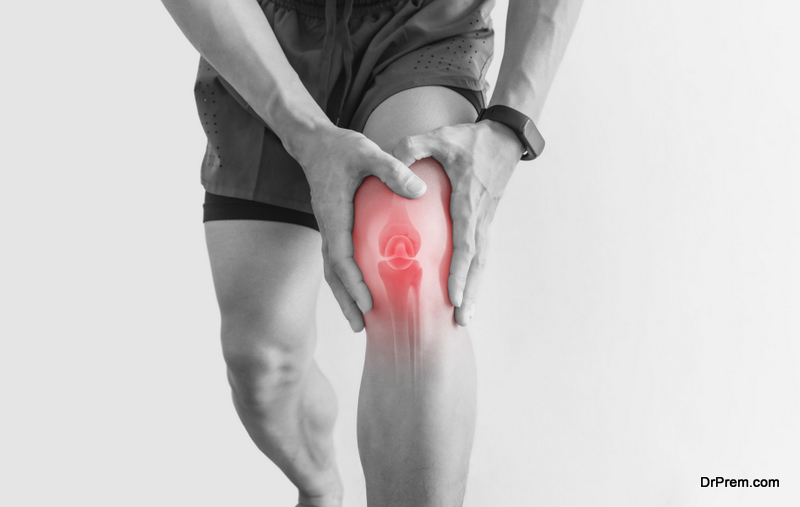Any rigorous activity or sport brings with it a high probability of getting a series of chronic injuries. There are various kinds of chronic injuries, tennis elbow, swimmer’s shoulder, runner’s knee & jumper’s knee, Achilles tendinitis, shin splints, ankle sprain, etc. With the help of the modern medicine and treatment, besides using proper protection, such as braces, plaster, heat plaster, cooling gel, sports bandage, orthopaedic belts, you can improve the degree of chronic injury. However, it is important to differentiate an acute injury from another chronic one for its treatment.
What is a chronic injury?
 During the practice of a physical activity, whatever intensity it may be, discomfort may appear and which usually affect the motor system. Acute injuries are those that happen just at the time when sports are being practiced. For example, a back sprain or strain. Chronic injury is one that occurs as a result of long-term sports practice. For example, knee problems, Achilles tendon injury, muscle swelling, or dislocations, etc. Keep in mind that during the practice of a sport certain parts of our body are in continuous movement. The repetition of the exercise produces overloads that favor the appearance of chronic injuries.
During the practice of a physical activity, whatever intensity it may be, discomfort may appear and which usually affect the motor system. Acute injuries are those that happen just at the time when sports are being practiced. For example, a back sprain or strain. Chronic injury is one that occurs as a result of long-term sports practice. For example, knee problems, Achilles tendon injury, muscle swelling, or dislocations, etc. Keep in mind that during the practice of a sport certain parts of our body are in continuous movement. The repetition of the exercise produces overloads that favor the appearance of chronic injuries.
Five tips to avoid chronic injury
Do you want to start doing physical exercise but you want it to be safe for your health? When we do physical exercise or a specific sport we have to start from a basic premise to enjoy what we do and to avoid unnecessary risks such as injuries. Another reality before starting with effective tips to prevent injuries is that injuries are part of sport and this is nothing new. Therefore, prevention is important so that your body is prepared for avoid injury.
1. Warm up and cool down
 Depending on the type of exercise you are going to do, you will need to activate some muscle groups or others before starting physical exercise. The important thing is that you perform exercises for the activation of large muscle groups, as well as dynamic stretching to prepare your muscles and joints for the effort to which they will be subjected later. It is also important that at the end of the session you carry out a progressive lap called “calm down”, including passive stretching and progressive slowing down until you return to rest.
Depending on the type of exercise you are going to do, you will need to activate some muscle groups or others before starting physical exercise. The important thing is that you perform exercises for the activation of large muscle groups, as well as dynamic stretching to prepare your muscles and joints for the effort to which they will be subjected later. It is also important that at the end of the session you carry out a progressive lap called “calm down”, including passive stretching and progressive slowing down until you return to rest.
2. Proper equipment
To exercise safely you will need your equipment to be adequate. A comfortable sports shoe accompanied by an ankle brace adapted to your foot depending on the type of activity you do, provides you with added safety and comfort, preventing future injuries. Wearing the right clothing, protection and gears for each type of activity is extremely important for your safety. With companies like Hansaplast India offering world class wound care and prevention products, it becomes very easy to avoid any kind of chronic injury.
3. Quality of the technique, intensity and advice
 It is important to do physical exercise but it is just as important to do it correctly. The correction of incorrect postures and inappropriate gestures in certain exercises, as well as the intensity or frequency of the exercises, are essential to prevent injuries.
It is important to do physical exercise but it is just as important to do it correctly. The correction of incorrect postures and inappropriate gestures in certain exercises, as well as the intensity or frequency of the exercises, are essential to prevent injuries.
Therefore, on certain occasions it will be necessary for a personal trainer specialized in injury prevention to guide us with the necessary corrections to optimize performance, incorporating exercises to enhance injury-sensitive areas and minimize the risk of injury due to inadequate technique.
4. Food, hydration and rest
It is important that you maintain a healthy diet so that your body obtains the necessary energy to withstand efforts of certain intensity and that it can regenerate easily. Second, it is important that you hydrate properly to allow you to exert yourself for a longer time and so that your tissues are elastic and flexible to be less sensitive to injury. Third, your rest is essential for your body to recover. A good rest will be great allies against injuries. Did you know that stress contributes to increasing the risk of injury?
5. Learn when to stop
 You cannot become Dwayne Johnson or MR. Bolt in just one day, will you? It is important that you learn to know your limits and know when to slow down or just stop. Did you know that overtraining can make us susceptible to major injuries, besides decreasing performance and the benefits of exercise?
You cannot become Dwayne Johnson or MR. Bolt in just one day, will you? It is important that you learn to know your limits and know when to slow down or just stop. Did you know that overtraining can make us susceptible to major injuries, besides decreasing performance and the benefits of exercise?
We hope that these five tips to prevent injuries will be put into practice in your day-to-day life and that they will help you improve your workouts, achieving your safety and avoiding unnecessary injuries.
Article Submitted By Community Writer




